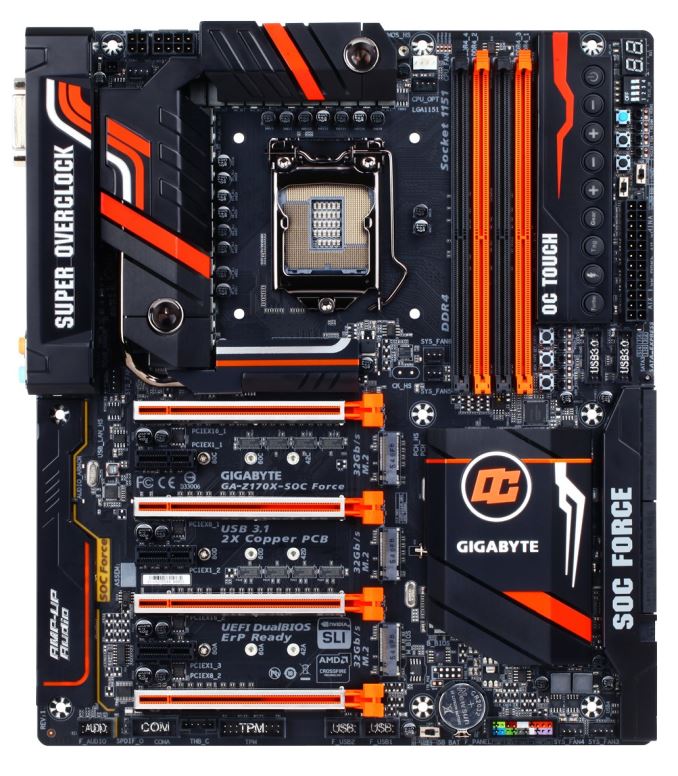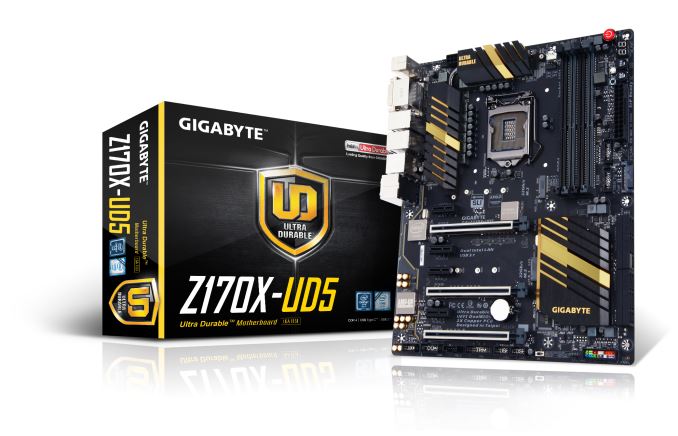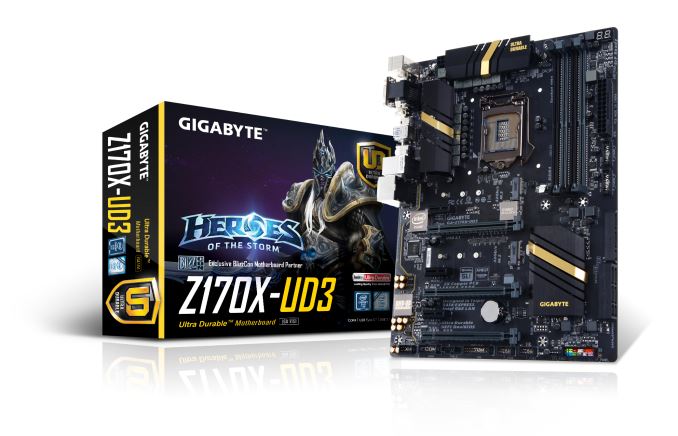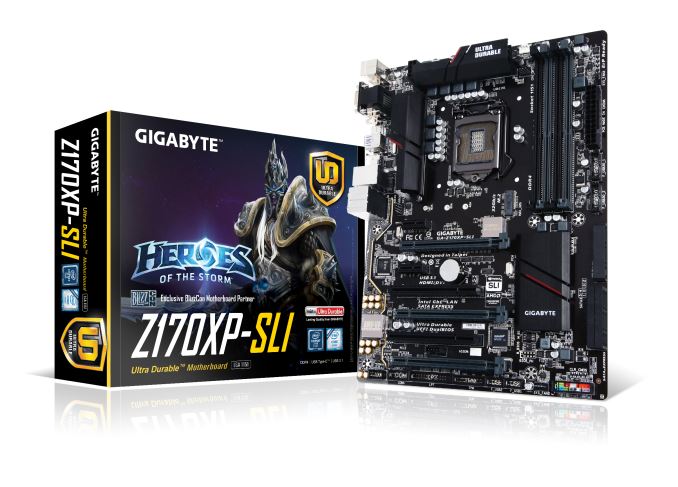Intel Skylake Z170 Motherboards: A Quick Look at 55+ New Products
by Ian Cutress on August 5, 2015 7:59 AM ESTGIGABYTE Z170: Super-Overclock and Ultra Durable
GIGABYTE Z170X-SOC Force
We’ve tracked GIGABYTE’s overclocking motherboards over the years, and interviewed motherboard product manager Jackson Hsu at the height of the Z87X-SOC launch when they were selling SOC motherboards quicker than they could be made. GIGABYTE tends to make anywhere from one to three overclocking models, including an ‘everything’ board and a ‘stripped’ version for extreme overclockers. At this point, the ‘everything’ board is the one being focused on.
We don’t have much information about the SOC Force at this time, but it is clear that the Force and the G1 are both aiming for the high end of their markets respectively. Similar to the G1 the power delivery heatsink is an air/water combination that stretches around the board. The SOC Force also has a 16+4+2 phase power arrangement, and under that second heatsink is also a PLX chip to allow for four-way SLI with x8/x8/x8/x8. The PCIe slots are also shielded to prevent damage, and between the slots are four separate M.2 PCIe 3.0 x4 slots.
The SOC Force as a whole moves into the E-ATX form factor, expanding to the right due to the OC Panel next to the DRAM slots. In an update to the design, rather than the previous array of buttons on the PCB they now have a cover with a large number of options beside it still. These options are for the extreme overclocking crowd, and no doubt GIGABYTE will be trying to challenge for records for the longevity of the platform.
The expanded PCB helps other features to fit on, such as the 8 SATA ports with the tri-SATA Express arrangement similar to the Gaming motherboards. For USB 3.1, the SOC Force has a Type-C and a Type-A on the rear panel, though at this time it is unclear if we are using the ASMedia ASM1142 or the Intel Alpine Ridge controller. The network controller is the Intel I219-V, escaping the clutches of the Killer line.
GIGABYTE has previously loved to play in the cheap overclocking space for mainstream platforms, and although we don’t have any information on a sub-$200 product coming, I would be surprised if one was not in the works.
GIGABYTE Z170X-UD5 - MSRP $190
GIGABYTE’s regular home-build motherboards form the Ultra Durable line, coming with a designation from UD3 to UD9. At this point in time only the UD3 and UD5 have been announced, and both look more like run-of-the-mill motherboards compared to their gaming counterparts. The styling is less garish with fewer custom LEDs or loud colors. That being said, both of them have similar hardware arrangements to the gaming line with the gaming parts replaced.
As a result, the UD5 here has a double Intel network solution, an enhanced Realtek ALC1150 audio orientation and standard three-way graphics support via x8/x4/x4. The PCIe shields are here by virtue of their use in actually supporting the PCIe slot rather than a gaming function. GIGABYTE is still using the Alpine Ridge controller for the USB 3.1 ports, here giving a USB 3.1-C and a single USB 3.1-A. There is no HDMI 2.0 on the UD5.
Storage comes via eight SATA ports, three SATA Express ports and the two M.2 slots in the middle of the board that run at full PCIe 3.0 x4 bandwidth. Given the UD5’s positioning, we might see it being bundled with an M.2 to U.2 converter – or if a UD7 comes out later, it might be added there.
GIGABYTE Z170X-UD3 - MSRP $165
The UD3 removes the PCIe metal shielding and dials down the heatsink styling again to a more reserved black and slightly gold look. We move down to a single network port, two fewer SATA ports and replace the DisplayPort with a VGA connector, but keep dual M.2 slots, the Alpine Ridge based USB 3.1 A+C combination and an x8/x4/x4 PCIe arrangement. The audio is also still GIGABYTE’s upgraded Realtek ALC1150 solution.
GIGABYTE Z170XP-SLI - MSRP $150
There also tends to be a model at the bottom of the Ultra Durable stack specifically for SLI. While not called ‘UD’ by name, the Z170XP-SLI carries the branding:
The Z170XP-SLI is the UD3 with even less styling on the power delivery, namely because the power delivery is dialed back for fewer phases. One of the internal PCIe 3.0 x1 slots also changes to a PCI slot by way of a bridge chip. This also seems to be the point where GIGABYTE changes to the ASMedia ASM1142 controller for USB 3.1 ports, and providing the A+C combination as before.
GIGABYTE Z170-D3H ($115) / Z170-HD3 ($115) / Z170-HD3P ($125)
The rest of the channel line we have information on focuses on the ‘3’ part of the product line, and as such aims for base functionality of the chipset with a few added extras with each name suggesting a different added feature that the others do not have. In this case, the D3H has an upgraded audio and Intel network controller while the other two have Realtek, and the HD3 is the one without USB 3.1 from the ASMedia controller. All three of these boards have a single PCIe 3.0 x16 and typically an x1 or x4 from the chipset, meaning that SLI will not work on them.

























_thumb.jpg)






_thumb.jpg)








85 Comments
View All Comments
stylinred - Thursday, December 24, 2015 - link
I have the mATX board, i like it! my only issues are:The pcie x16 is too close to the cpu, when using air cooling, and something large like the Noctua 15, the radiator fins sit right up against the GPU.
When using the Pci-e x16, the pci-e x1 is blocked and the Sata connections are blocked by GPU's so be sure to install your sata devices first
ParimalV - Wednesday, February 3, 2016 - link
I am confused that which of these motherboards have illuminated msi branding on the heatsink like asus rog motherboards have that eyes which can glow on heatsinkgsuburban - Friday, February 5, 2016 - link
Not enough SATA 3 ports, only 4, and no display port ?mathiash - Sunday, June 26, 2016 - link
Asrock should always get extra stability tests, especially their ITX boards. People are reporting nothing but trouble with these.gsuburban - Saturday, July 16, 2016 - link
My only beef with the new M.2 tech motherboards is; when using an M.2 drive, it disables a SATA 3 port. On some other brands, one M.2 drive will disable 2 SATA 3 ports. Either the chipset or the board designers need to configure to allow all ports to function. Many users, have several HDD's for storing their documents (user account) on them vs. on the M.2 plus back up needs such as images and file backups.I'm still wondering why the current boards bother with the 15-D video connector and why some don't use an HDMI video port while opting for the display port. HDMI is the future for anyone who will be looking for BluRay full audio functionality and HDMI is the only interface that supports it via the HDMI v2.0 and HDCP v2.2